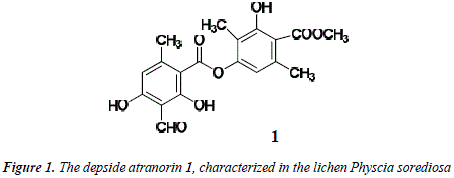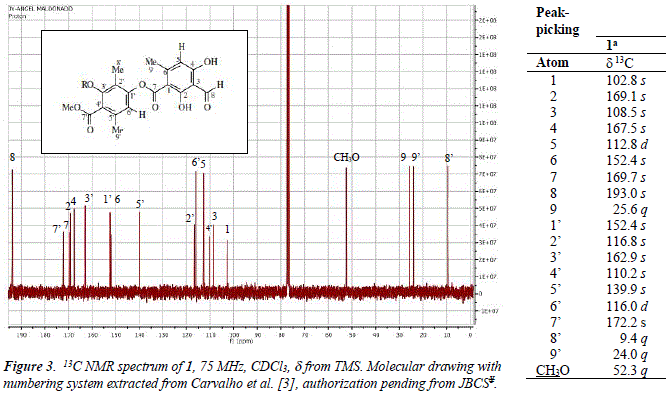Services on Demand
Journal
Article
Indicators
-
 Cited by SciELO
Cited by SciELO -
 Access statistics
Access statistics
Related links
-
 Similars in
SciELO
Similars in
SciELO  uBio
uBio
Share
Revista Boliviana de Química
On-line version ISSN 0250-5460
Rev. Bol. Quim vol.33 no.5 La Paz Dec. 2016
ARTÍCULOS ORIGINALES
Presence of atranorin in Physcia Sorediosa
Short report
Ángel Maldonado Montano1, Rosaicela Menesses2, José A. Bravo3, José L. Vila1,*
*Corresponding author:joselu62@hotmail.com
Abstract
In this short report we inform over the presence of the depside named atranorin in the lidien Physcia sorediosa (Physciaceae) by means of isolation techniques and structural characterization by using NMR techniques. The lichen was collected at the UMSA campus Cota Cota in La Paz. To the best of our knowledge this is the first characterization of this depside in the lichen Physcia sorediosa.
Keywords: Physcia sorediosa, Atranorina, NMR.
Resumen
Spanish title: Presencia de atranorina en Physcia sorediosa. Reportamos la presencia del depsido denominado atranorina en el liquen Physcia sorediosa (Physciaceae) mediante su aislamiento y caracterización por RMN, el liquen fue colectado en el campus Universitario de Cota-Cota, UMSA, La Paz Bolivia.
INTRODUCTION
Lichens are vegetal organisms generated by the symbiosis of algae and mushrooms [1]. They synthesize secondary metabolites as depsides, terpenoids, acids, quiñones, chromones, xanthones and anthraquinones [2]. In our study of the lichen Physcia sorediosa, collected in the main campus of UMSA in La Paz (3600 m.a.s.L), we have isolated the depside atranorin 1, see Figure 1. The structure was assigned by analysis of the 1H NMR and 13C NMR data of compound 1 (Fig. 2 and 3, Table 1) in comparison with those published in the literature for atranorin [3].
RESULTS AND DISCUSIÓN
Atranorin (1, IUPAC ñame: (3-hydroxy-4-methoxycarbonyl-2,5-dimethylphenyl)3-formyl-2,4-dihydroxy-6-methylbenzoate) was obtained as white crystals. The ID NMR spectra are shown in Figure 2 and 3. There is a report of Carvalho et al. [3] in which the unambiguous assignment of the 1H and 13C NMR spectra was established. The elucidation work done by Carvalho et al. [3] included the use of 2D NMR techniques, namely, COSY, NOESY, HMQC and HMBC. We have also established all necessary homo and heteronuclear correlations through 2D NMR techniques; results are coinciding with the results published by Carvalho et al. [3]. Table 1 shows the comparison of chemical shift valúes of atranorin (1a) isolated from Physcia sorediosa with those of atranorin (1b) isolated from Ouratea floribunda [3]. These data permitted to identify the compound isolated from Physcia sorediosa and reported here, as atranorin (1). These valúes were also correlated with spectrometric additional bibliographic information in order to corrobórate the identity of 1 [4-6]. To the best of our knowledge this is the first characterization of atranorin in the lichen Physcia sorediosa.
EXPERIMENTAL
General
The NMR spectra were run in a Bruker DRX300, (300 MHz 1H, 75 MHz 13C) equipment at the Department of ChemistryofUMSA.
Vegetal material
Physcia sorediosa was collected at the main Campus of Major San Andrés University (UMSA) at 3600 m.a.s.l. (La Paz, Bolivia) in December 2005, the material was identified in the National Herbarium of Bolivia (LPB).
Extraction and isolation
The plant material was selected, cleaned, dried and milled, it weighed 10.1 g. 10.1 g of dried material was extracted with acetone during 48 h. at room temperature. The fíltrate was concentrated at reduced pressure and once dried it was crystalized in ethanol-dichloromethane (1:1) to afford a white crystalline solid or compound 1 (0.6 g, 5.94%).
ACKNOWLEDGEMENTS
Authors wish to thank Dr. Yonny Flores Segura, Laboratory of NMR, Department of Chemistry, UMSA for the recording of NMR spectra. The Research Institute of Natural Products (IIPN) is acknowledged for financial support.
NOTE
1 Department of Chemistry, Research Center of Natural Products CIPN, Laboratory of Synthesis and Hemisynthesis of Natural Products, Universidad Mayor de San Andrés UMSA, P.O. Box 303, Calle Andrés Bello s/n, Ciudad Universitaria Cota Cota, Phone 59122795878, La Paz, Bolivia, joselu62@hotmail.com
2 Department of Biology, Ecology Institute IE, National Herbarium of Bolivia LPB, Universidad Mayor de San Andrés UMSA, P.O. Box 10077, Calle Andrés Bello s/n, Ciudad Universitaria Cota Cota, Phone 59122792582, La Paz, Bolivia, lpb@acelerate.com
3 Department of Chemistry, Research Center of Natural Products CIPN, Laboratory of Phytochemistry, Universidad Mayor de San Andrés UMSA, P.O. Box 303, Calle Andrés Bello s/n, Ciudad Universitaria, Cota Cota, Phone 59122792238, La Paz, Bolivia, jabravo@umsa.bo
REFERENCES
1. Purvis, W. Lichens, Smithsonian Institution Press, 2000, Washington D.C., USA. [ Links ]
2. Hale, M., The Biology of lichens, Spottiswoode Ballantyne Ltd. Press, 3rd ed., 1983, London, U.K. [ Links ]
3. Carvalho, M.G., Carvalho, G.J.A., Braz-Filho, R. 2000, Chemical constituents from Ouratea floribunda: complete 1H and 13C NMR assignments of atranorin and its new acetyl derivative. J. Braz. Chem. Soc, 11 (2), 143-147. [ Links ]
4. Vila, J.L., Mollinedo, P., Sterner, O. 2011, Spectrometric studies of lichen depsides and depsidones, Rev. Bol. Quim., 28(1), 28-34. [ Links ]
5. Sundholm, E.G., Huneck, S. 1980, 13C NMR spectra of lichen depsides, depsidones and depsones. 1. Compounds of the orcinol series, Chemica Scripta, 16, 197-200. [ Links ]
6. Sundholm, E.G., Huneck, S. 1981, 13C NMR spectra of lichen depsides, depsidones and depsones. 2. Compounds of the P-orcinol series, Chemica Scripta, 18, 233-236. [ Links ]
¥Journal ofthe Brazilian Chemical Society


















